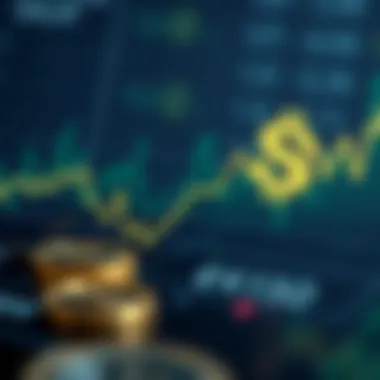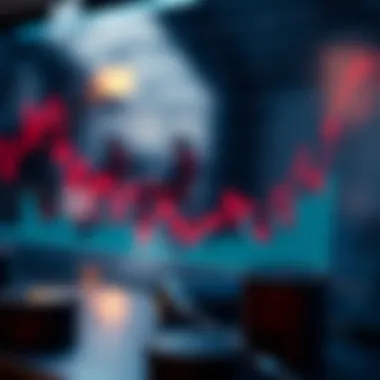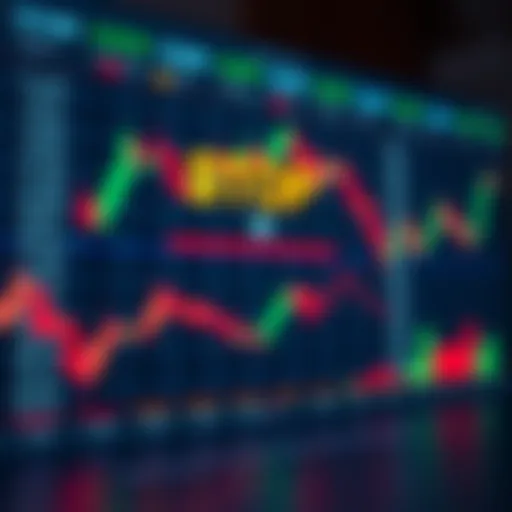Understanding the Euro to Dollar Exchange Rate Dynamics


Intro
The Euro to Dollar exchange rate is a linchpin in the realm of global finance. Its fluctuations can ripple through markets and impact decisions across continents, affecting not just investors but everyday individuals too. Each tick of the exchange rate can carry significant consequences, as trade, tourism, and investment flows depend heavily on it. It’s not just about numbers on a screen; it shapes the economic landscape and can often be a barometer of international economic health.
In this article, we will explore the multifaceted dynamics behind this exchange rate, its historical context, and what influences its movement. By diving deeper into the mechanisms of the market, we will illuminate the path for those either curiously observing or actively investing in the currency showdown between the Euro and Dollar.
Let’s get into the nitty-gritty of it all, highlighting key market analysis, investment strategies, and various factors that contribute to the Euro to Dollar exchange rate.
Market Analysis
Understanding market behavior and trends is vital when navigating the world of currency exchanges. The Euro to Dollar exchange rate doesn't exist in a vacuum; it is influenced by a cocktail of economic indicators, geopolitical factors, and market sentiment.
Current Trends in Cryptocurrency
In recent years, cryptocurrency has made waves, often moving in tandem with traditional currency markets. The exchange rate between currencies can be swayed by the overall strength or weakness of cryptocurrencies. When Bitcoin or Ethereum make headlines for soaring values, this can inadvertently impact how investors approach Forex trading. In this regard, a strong Bitcoin might lead to increased investor confidence in the Euro against the Dollar, affecting trades and decisions.
The interaction between traditional currencies and cryptocurrencies also brings volatility to the exchange rate. Speculators sometimes jump ship from traditional assets to digital currencies, creating a domino effect on the Euro to Dollar exchange rate.
Price Prediction Techniques
Price prediction in Forex markets is akin to a chess game—each move matters. Various techniques are employed by traders to anticipate changes in the Euro to Dollar exchange rate.
- Technical Analysis: Traders often rely on charts, patterns, and historical price movements to make forecasts about future behavior. Indicators such as moving averages and Fibonacci retracement levels can be insightful.
- Fundamental Analysis: Economic news—like interest rate changes or employment data—can sway the exchange rate significantly. Understanding economic calendars and news cycles can provide an edge.
- Sentiment Analysis: Gauging market sentiment via surveys or indicators can hint at future movements. If the majority of traders are bullish, it can create upward pressure on the Euro.
Ultimately, these techniques are not foolproof but can provide a framework for making educated decisions.
Investment Strategies
When it comes to investing, there’s no one-size-fits-all approach; different strategies can be tailored based on personal goals and risk tolerance.
Long-Term vs Short-Term Investing
Investors need to decide whether they’re in it for the long haul or if they prefer quick gains. Long-term investing in the Euro to Dollar exchange rate typically involves holding onto assets during market fluctuations, believing that the overall trend will favor the investor later on. Short-term trading, however, takes advantage of immediate movements and volatility, relying heavily on technical analysis. Each strategy carries its own set of risks and rewards.
Risk Management in Crypto Trading
If incorporating cryptocurrency into the investment mix, risk management is crucial. Here are a few vital strategies:
- Diversification: Spread your investments across multiple currencies to mitigate risk.
- Stop-loss Orders: Automate protections in case of sudden market reversals to limit potential losses.
- Position Sizing: Determine the size of your trades based on your overall portfolio value to manage exposure.
"In Forex, it’s not about being right; it’s about managing your risk and surviving the trades."
Having a clear risk management strategy fosters discipline and keeps emotions in check, essential in the unpredictable world of currency exchange.
Preamble to Currency Exchange
The realm of currency exchange is a fundamental aspect of global finance that impacts a multitude of economic activities. When we talk about currency exchange, we're diving into the mechanics of how different money units interact, the factors that drive these interactions, and the significance for businesses, travelers, and investors alike. Understanding this topic sets the groundwork for navigating the complexities of financial markets, particularly when dealing with currencies like the Euro and the Dollar.
Defining Currency Exchange
Currency exchange refers to the process of converting one currency into another, a practice as old as trade. Essentially, each currency has its own value, determined by various economic and political factors. For instance, if you are traveling from the United States to France and you exchange your Dollars for Euros, the rate at which you make this exchange is influenced by the current market conditions. This rate can fluctuate throughout the day, driven by the demand for each currency and a host of other indicators such as interest rates and economic stability.
Exchange rates are not set in stone; they can change daily, sometimes even by the minute. For example, during major global events or economic shifts, the value of the Euro against the Dollar can swing dramatically, marking significant opportunities or risks for those involved.
Importance for Investors
The ability to understand currency exchange holds immense importance, particularly for investors. For a variety of reasons, the exchange rate between the Euro and Dollar can have a considerable impact on international investments, trading strategies, and overall portfolio performance.
- Investment Opportunities: Investors can capitalize on fluctuations in exchange rates to achieve better returns on investments. A favorable exchange rate can mean a larger profit margin when converting earnings back into one's home currency.
- Hedging Against Risks: Knowledge of currency exchange can be vital for hedging strategies, allowing investors to protect their portfolios from adverse currency movements.
- Global Market Coherence: As the Euro and Dollar are two of the most widely traded currencies globally, being aware of their exchange rate helps investors to comprehend broader market trends and to foresee potential shifts in the economic landscape.
- Informed Decision Making: Investors who keep abreast of currency trends can make informed decisions about when to enter or exit certain markets based on projected currency movements.
Thus, understanding currency exchange is not merely an academic exercise; it has real-world implications that can ultimately determine financial success or failure in the competitive landscape of global trading.
Overview of the Euro and Dollar
In the realm of global finance, the Euro and Dollar stand as titans among currencies. Their interplay not only shapes the economic landscape of Europe and the United States but also reverberates through international markets, trading strategies, and investment portfolios. This section will break down the key historical and contextual underpinnings of both currencies, offering insights into their foundational roles in modern finance. Understanding these elements is crucial for investors, traders, and analysts who want to make educated decisions in their financial endeavors.
Historical Context of the Euro
The Euro was introduced in 1999 as a response to an increasingly interconnected Europe, looking to foster economic stability and ease trade between member nations. The idea was to create a currency that could challenge the dominance of the Dollar on the world stage. Since its inception, the Euro has undergone numerous trials and tribulations, not least during the Eurozone crisis of the late 2000s. Several countries, particularly Greece, brought the stability of the Euro into question, leading to significant fluctuations in its value against the Dollar.


Over the years, the Eurozone has seen phases of growth and recession, influenced by various economic indicators such as GDP, inflation rates, and unemployment figures across member states. The Euro’s introduction wasn't merely a financial maneuver but a political statement—a sign of unity against the backdrop of historical conflicts in Europe.
Today, it stands as the second most traded currency in the world, trailing only behind the Dollar. This journey reflects various significant historical events that have shaped the Euro, and understanding these can provide investors with a clearer picture of its potential for future growth.
The Dollar's International Role
The Dollar, being the oldest and most entrenched global currency, plays a monumental role in international finance. Its status stems from a variety of factors, including the size and strength of the U.S. economy, its extensive network of trade relationships, and its role as a safe haven in times of economic uncertainty. The Dollar is often seen as the world's reserve currency; countless nations hold dollars in their foreign exchange reserves, making transactions easier across borders.
Moreover, commodities like oil and gold are typically priced in Dollars, cementing its status as a linchpin in global trade. This reliance allows for the U.S. to exert significant influence over international affairs, with fluctuations in the Dollar’s value impacting everything from global trade agreements to inflation rates in developing nations.
The Dollar's strength or weakness can shift the balance of power in global markets, affecting everything from consumer prices to geopolitical stability.
Investors need to be vigilant about how the interplay between the Euro and Dollar influences the broader economic environment. Understanding the historical context of these two currencies gives a solid foundation for analyzing current trends and making strategic investment choices.
Mechanisms of Currency Exchange Rates
Understanding the mechanisms behind currency exchange rates provides crucial insights for investors and analysts alike. Currency exchange rates don't simply float on their own; they stem from a complex interplay of market conditions, economic policies, and geopolitical events that are constantly shifting. Recognizing these mechanisms aids in predicting movements in the Euro to Dollar exchange rate, thereby helping stakeholders make informed decisions when it comes to investing and trading.
Market Forces Driving Exchange Rates
At the heart of the currency exchange, we find the forces of supply and demand. Just like any other commodity, currencies are bought and sold based on their perceived value. Factors affecting this perception can be varied:
- Interest Rates: Higher interest rates offer lenders a higher return relative to other countries. As a result, higher rates attract foreign capital and cause the exchange rate to rise.
- Economic Indicators: Reports such as GDP growth rates, employment levels, and inflation influence how traders see a currency's strength. For example, an improving economy generally strengthens a currency.
- Political Stability: Countries that are perceived as stable are more attractive to foreign investors. Any sign of political turmoil can lead to a depreciation of the currency.
To put it simply, if more people want to buy a currency than sell it, the price will go up—and vice versa.
"Demand drives value; whether it's bananas or bucks, it all comes down to supply and demand!"
It's worth noting that these forces fluctuate based on market sentiment too. Traders often react on instinct or news, causing abrupt shifts in currency values.
Central Bank Influence
Central banks, like the European Central Bank (ECB) for the Euro and the Federal Reserve for the Dollar, wield substantial influence over currency values. They employ various monetary policy tools to manage economic performance:
- Interest Rate Decisions: By raising or lowering benchmark interest rates, central banks can directly influence the value of their currencies. A hike in rates generally boosts the currency's strength, making it more attractive to investors seeking better returns.
- Open Market Operations: This involves buying or selling government securities in the open market to influence liquidity and interest rates. Such actions can have rippling effects on the exchange rate.
- Quantitative Easing (QE): In times of financial crisis, central banks might inject money into the economy by buying assets, aiming to stimulate growth. This influx can lead to a weaker currency if not managed properly.
In essence, the decisions made by these entities can steer the course of currency exchange rates and play a significant role in shaping the prospects for both the Euro and Dollar. Being aware of these mechanisms empowers investors to anticipate potential shifts and adapt accordingly.
Factors Affecting Euro to Dollar Exchange Rate
Economic Indicators
Economic indicators act as the barometer of a country's financial health. When analyzing the euro to dollar exchange rate, certain indicators become pivotal. Gross Domestic Product (GDP) growth rates, unemployment figures, and inflation data tell much about the economic vitality of the Eurozone and the U.S. A robust growth rate in the euro area, for instance, might suggest stronger demand for euros, thereby raising its value against the dollar.
- Interest Rates: One of the most significant economic indicators involves the interest rates set by the European Central Bank and the U.S. Federal Reserve. Higher interest rates in the Eurozone typically lead to an inflow of capital from investors seeking higher returns, thus strengthening the euro.
- Trade Balances: Furthermore, the trade balance is essential in this domain. A surplus in trade for the eurozone might reflect a strong demand for European goods, boosting the euro’s position against the dollar. Conversely, a trade deficit in the U.S. could lead investors to reevaluate their confidence in the dollar.
A keen eye on these indicators allows investors to gauge potential fluctuations in the exchange rate, providing a basis for making sound financial choices.
Political Stability and Events
The political landscape significantly impacts currency values, including the euro and the dollar. Political stability tends to foster a conducive environment for investment, whereas instability often leads to uncertainty which can negatively affect currency performance. Political events, such as elections, referendums, and governmental policies, can sway market perceptions in a heartbeat.
"Events that create uncertainty often lead investors to flock towards safe-haven currencies like the dollar; this can cause rapid shifts in the exchange rate."
- Government Actions: Furthermore, actions taken by governments, such as the implementation of new regulations or responding to economic crises, can create ripples across the forex market. For example, decisive leadership during a financial crisis might bolster confidence in the euro, leading to appreciation against the dollar.
- International Relationships: The geopolitics between the U.S. and Europe, including trade agreements and diplomatic gestures, also plays a role. Positive interactions may result in favorable economic policies, affecting how the markets view both currencies.
Understanding the political context helps investors anticipate changes, as political shifts can transform market sentiment almost instantaneously.
Market Sentiment and Speculation
Market sentiment, often driven by trader beliefs and news, is a less tangible but equally significant factor affecting the euro to dollar exchange rate. Whether based on positive economic forecasts or looming doubts, market sentiment can lead to swift movements in currency value.
- News and Media Influence: Major news events can trigger massive trading volumes, as investors react to immediate headlines. A surprise decision by the European Central Bank or an unexpected economic report could lead to knee-jerk reactions in the market.
- Speculation: Speculation plays a central role here too. Traders buy and sell currencies based on their expectations of future movements, often causing the currency’s value to fluctuate independently of the actual economic situation. A widespread belief that the euro will strengthen because of anticipated economic improvements can drive its value up, regardless of current statistics.
Historical Trends in Euro to Dollar Rates
Understanding historical trends in the Euro to Dollar exchange rate is crucial for investors and traders seeking to navigate the complexities of the Forex market. This section sheds light on the significant shifts in the exchange rate over the years, showcasing how geopolitical events, economic indicators, and market sentiment have influenced these fluctuations. By analyzing past trends, investors can better comprehend current dynamics and forecast potential movements, making informed decisions in their trading strategies.
Significant Historical Fluctuations


Historically, the Euro to Dollar exchange rate has experienced notable fluctuations that echo larger economic tides. The inception of the Euro in 1999 marked a pivotal moment, initially being valued at approximately 1.17 dollars. However, shortly after its launch, the Euro faced substantial devaluation, reaching lows of about 0.83 dollars in 2001. This initial dip stemmed from skepticism about the new currency and concerns surrounding Europe’s economic stability.
In 2008, the financial crisis shook the globe, leading to dramatic fluctuations in currency values. The Euro reached its apex, hitting nearly 1.60 dollars in mid-2008, driven by a mix of European resilience and American economic woes. However, post-crisis recovery saw the Dollar regain strength, leading to a decline in the Euro's value, signaling a shift in economic dominance.
"The swings in the Euro to Dollar rates reflect more than just speculation; they are mirrors to global economic confidence and geopolitical stability."
Additionally, events such as Brexit in 2016 significantly impacted the Euro, creating ripples that extended into the Dollar's performance as traders reassessed the European landscape. Such events highlight the interconnectedness of global currencies and the importance of staying abreast of international news and economic forecasts.
Comparative Analysis Over Decades
Delving deeper into a comparative analysis over decades reveals patterns that can guide future predictions. During the early 2000s, the Euro largely traded below 1.25 dollars. The subsequent decade, however, witnessed a bullish trend, predominantly from 2005 to 2008, where the Euro escalated rapidly as the U.S. grappled with economic setbacks.
The decade from 2010 to 2020 was marked by volatility, largely influenced by the Eurozone debt crisis and fluctuating Federal Reserve monetary policies. Here’s a breakdown:
- 2000-2009: Initial years of uncertainty, followed by bullish trends leading to the 2008 peak.
- 2010-2019: A seesaw between confidence and fears of instability due to the Eurozone crisis, showcasing sensitivity to economic indicators.
- 2020-Present: The COVID-19 pandemic has further complicated the landscape, although recent recovery signs suggest cautious optimism.
This comparative analysis not only demonstrates how external factors play a significant role in currency valuations but also serves as a testament to the resilience of the Euro and the Dollar amidst economic uncertainty. Staying informed about both past and current trends can provide investors with insights into future shifts, fostering a more nuanced understanding of currency trading.
Current Trends and Forecasting
Recent Market Movements
In the volatility of currency markets, the Euro and Dollar have had their fair share of ups and downs. A noteworthy spike occurred when economic data from the Eurozone painted a more favorable picture than anticipated. For instance, a sudden drop in unemployment rates in Germany coupled with a surprising rebound in manufacturing output pushed the Euro upwards, challenging the Dollar's previous stronghold.
Moreover, events like the Federal Reserve's interest rate decisions have profound implications as they influence investor sentiment. When the Fed raised rates recently, the Dollar strengthened substantially, reflecting traders' expectations for a more robust U.S. economy.
Currently, many analysts are keeping a close eye on inflation rates because they profoundly affect currency strength. If inflation rises in the Eurozone, the European Central Bank might react, potentially tightening monetary policy or raising interest rates, which could alter the dynamics between these two currencies.
Market movements also display tendencies shaped by geopolitical factors. Changes in trade relationships, political unrest, or even an unexpected election outcome can sway the exchange rate as investors react to news that could impact economic forecasts.
Key movements to note:
- Euro resilience against the Dollar during positive economic reports
- Dollar strengthening in response to rate changes by the Federal Reserve
- Increased volatility due to geopolitical events influencing investor confidence
Analyst Predictions
Looking ahead, numerous analysts feel cautiously optimistic about the Euro. Some forecasts suggest that if the Eurozone continues to show resilience, the Euro could gain ground against the Dollar. A recent report from an investment bank highlights the potential for a long-term uptrend if key economic indicators continue on their current trajectory.
However, it's essential to acknowledge the unpredictable nature of these forecasts. While analysts base predictions on economic models and historical data, sudden shifts in global markets can throw even the most meticulous predictions off balance. Industry experts often urge investors to consider this unpredictability in their strategies.
Analysts also emphasize that market sentiment plays a pivotal role. A report from Bloomberg recently mentioned how speculative positions can create artificial strength in one currency over another. Thus, sentiment, driven by news or broader economic trends, can influence short-term forecasts—making it crucial for investors to keep an ear to the ground.
In a nutshell:
- Bullish sentiment: Positive economic indicators in the Eurozone may lead to Euro appreciation.
- Bearish risks: Any adverse geopolitical events could derail forecasts, leading to Dollar strength.
- Volatility ahead: Traders should brace for possible swings in rates as analysts dissect every piece of economic data released.
As markets are inherently unpredictable, prudent risk assessment and tailored strategies can help navigate potential pitfalls.
Impact on the Cryptocurrency Market
Understanding the connection between traditional currencies and cryptocurrencies holds substantial value in today's financial landscape. With the Euro and Dollar being two of the world’s most influential currencies, their exchange rates can have ripple effects on various assets, particularly cryptocurrencies. These digital currencies are often viewed as alternative investments, and fluctuations in fiat currency values can influence their pricing and market stability.
As cryptocurrency enthusiasts and investors keep a close eye on currency exchange trends, it is crucial to assess how movements between the Euro and Dollar can directly affect crypto asset valuations. This section delves deep into the interrelation of these currencies and the growing significance they play in the realm of digital assets.
Interrelation of Currencies and Cryptos
The relationship between fiat currencies, specifically the Euro and Dollar, and cryptocurrencies cannot be overstated. As more investors turn to digital currencies for diversification, shifts in the value of the Euro against the Dollar can influence the buying power and investment strategies of global traders. Here are some key points to consider:
- Exchange Rate Volatility: When the Euro weakens against the Dollar, investors in Europe may find their purchasing power diminished, which can lower demand for cryptocurrencies priced in Dollars.
- Market Sentiment: Traders often react to changes in exchange rates. A stronger Dollar might push investors towards Dollar-denominated cryptocurrencies, whereas a stronger Euro might do the opposite.
- Arbitrage Opportunities: Discrepancies in exchange rates can create unique opportunities for traders. Capitalizing on these shifts, investors can buy cryptocurrencies in one market and possibly sell in another for profit, further intertwining the worlds of fiat and crypto.
Case Studies of Currency Shifts
To illustrate the impact of currency fluctuations on the cryptocurrency market, consider a couple of scenarios:
- Event of 2015: The Greek financial crisis prompted significant shifts in Euro prices. The uncertainty drove many investors towards Bitcoin, which at the time was viewed as a safe haven asset. As such, the price of Bitcoin surged, showcasing a clear link between the stress on the Euro and increased demand in the crypto market.
- Late 2020 Trends: The COVID-19 pandemic saw significant economic stimulus, influencing both the Euro and Dollar. The Euro gained power against the Dollar in early 2021, which led to notable shifts in Ethereum and Bitcoin prices. Investors reacted to their fluctuating relevance as stores of value, timing their transactions based on fiat performance.
"The links between fiat currencies and cryptocurrencies reveal the complex interplay of market forces, highlighting the need for savvy investors to stay informed on both fronts."
For more related insights, readers can explore resources at Wikipedia and Investopedia.


Practical Advice for Currency Exchange
When dealing with the Euro to Dollar exchange rate, practical advice serves as the backbone for make informed decisions. It’s not merely about knowing the rates; it’s about understanding the timing, the platforms, and the broader implications of currency exchange. For investors, traders, and everyday individuals alike, there are numerous aspects to consider. The advice provided in this section will clarify how to approach the complexities of currency adjustments, ensuring a smoother and more profitable exchange experience.
When to Exchange Currency
Timing can feel like an art form when it comes to currency exchange. Just like trying to hit a moving target, the best moment to exchange can shift in a flash. Here are some key indicators to gauge the right moment:
- Economic News Releases: Stay updated on financial news. Events such as employment figures, GDP growth, and inflation reports can sway exchange rates significantly. For example, if the Eurozone reports a strong economic outlook, expect the Euro to appreciate against the Dollar.
- Central Bank Announcements: Regularly monitor the European Central Bank and the Federal Reserve for policy decisions. Interest rate changes can act as a harbinger for currency movements. If, say, the Fed raises interest rates while the ECB holds steady, the Dollar might become more desirable, leading to an uptick in its value against the Euro.
- Market Sentiment: Keep an ear to the ground about market sentiments. Investors’ attitudes—whether optimistic or pessimistic—can steer currency values in unexpected directions. Social media forums like Reddit often host discussions that reveal crowd sentiment towards currencies; this informality can offer precious insight.
- Seasonal Trends: Certain times of year can affect exchange rates too. For example, increased travel during summer can boost demand for Euros, nudging their value upward. Knowing the cyclical patterns can help plan exchanges better.
The essence is to remain alert and engage with relevant sources. Check financial news outlets and market analysis platforms regularly to be in sync with current economic stimuli.
Choosing Reliable Platforms
With the variety of platforms available for currency exchange, knowing which one to trust can be challenging. A few essentials to consider when making your selection include:
- Reputation and Reviews: Look for platforms that have built a strong reputation over time. Websites like Trustpilot or financial forums can provide guidance on user experiences and reliability.
- Transparent Fees: Always read the fine print! Compare the fees charged by different platforms. Some may offer attractive exchange rates but hide fees in the conversion process. Ensure you understand how much you’re actually paying to avoid unwelcome surprises.
- Security Measures: It’s critical that any platform you use employs strict security measures. Look for platforms that are regulated and offer two-factor authentication. This helps protect personal and financial information.
- User-Friendly Interface: A simple, straightforward interface can make a significant difference. The last thing you want during an exchange is to wade through a complicated platform with slow loading times or unclear instructions.
Ultimately, selecting the right platform for currency exchange can empower you to navigate fluctuations effectively and ensure your investments are safeguarded. Spending a little time researching and choosing wisely can go a long way in fortifying your trading strategies.
"A penny saved is a penny earned, but a timely exchange can be the difference between a dollar gained and a dollar lost."
By focusing on the elements outlined above, you can enhance your approach to currency exchange, master the timing, and engage with trustworthy platforms. Doing so is not just about keeping up with the current rates; it’s about making informed decisions that can lead to greater financial success.
Investment Strategies Involving Euro and Dollar
Understanding investment strategies involving the Euro and Dollar provides investors with a significant edge in navigating the currency markets. The dynamics of these two currencies can influence global financial trends, and making informed choices can either fortify or hinder one’s investment portfolio. This section delves into the various strategies investors utilize to maximize gains while safeguarding against risks associated with currency movements.
Hedging Against Currency Risk
Investors are often like acrobats balancing on a tightrope; even the slightest misstep can lead to substantial losses. One common strategy to mitigate such risks is hedging. Hedging against currency risks, particularly between the Euro and Dollar, involves taking positions that counterbalance potential loss from adverse currency movements. It is akin to employing insurance for your investments, shielding them from unexpected price swings.
There are various tools for hedging:
- Forward Contracts: These are agreements to exchange currency at a predetermined rate at a future date. They act like a safety net, guaranteeing a rate regardless of market fluctuations.
- Options: Currency options provide the right, but not the obligation, to convert currency at a set rate. This flexibility allows investors to capitalize on favorable movements while limiting potential loss during downturns.
- ETFs and Mutual Funds: Many exchange-traded funds and mutual funds focus on currency pairings, providing investors an easy way to gain exposure to Euro-Dollar movements while spreading risk across various assets.
Utilizing these instruments can help investors maintain a steadier performance in their portfolios, especially during turbulent market conditions
Long-Term vs Short-Term Approaches
When drawing up an investment plan regarding the Euro and Dollar, one size does not fit all. Investors must decide whether they intend to pursue long-term or short-term strategies, each with its own unique set of considerations.
Long-Term Approaches:
- Investors looking at the Euro and Dollar from a long-term perspective often focus on macroeconomic indicators and trends. It’s about seeing the bigger picture and looking at how geopolitical factors, trade balances, and economic policies might shift over time.
- They usually rely on fundamental analysis, which involves evaluating the economic health of the Eurozone compared to the United States. Monitoring interest rates, inflation rates, and economic growth forecasts plays a pivotal role. For instance, if the Eurozone is showing solid growth indicators while the US economy is lagging, long-term investors may boost their positions in Euros.
Short-Term Approaches:
- Conversely, short-term traders or speculators might emphasize technical indicators, seeking to capitalize on quick price movements. These traders tend to follow charts and patterns, reacting swiftly to economic news releases or market sentiment shifts.
- They thrive in a fast-paced environment, making decisions based on pulse of the market and often utilize strategies like day trading or scalping, which involve buying and selling positions within hours or even minutes.
In summary, whether opting for long-term steadiness or short-term agility, the effectiveness of strategies involving the Euro and Dollar lies in understanding the market landscape and acknowledging one's investment goals.
"In the world of currency trading, adaptability is paramount. Investors must continually adjust their strategies to accommodate the ever-changing market."
For additional insights on managing currency investments, consider checking resources like Investopedia that provide expert articles and tutorials on these strategies.
Culmination and Future Considerations
In wrapping up this exploration of the Euro to Dollar exchange rate, it’s clear that we’ve scratched the surface of a topic laden with nuances. Understanding this rate is not just about monitoring numerical values; it’s about grasping the broader implications these fluctuations have on the global economic tapestry.
As we step into an increasingly interconnected world, recognizing the significance of the Euro to Dollar relationship becomes imperative for investors, traders, and even casual followers of the financial markets. The movements of this currency pair can signal shifts in economic power, influence policymaking, and even impact personal investments.
Summarizing Key Insights
Looking back, several key insights emerge:
- Market Sensitivity: The Euro to Dollar exchange rate is extraordinarily sensitive to macroeconomic indicators such as GDP growth, unemployment rates, and inflation. Investors need to keep an eye out for these indicators to gauge potential shifts.
- Political Landscape: Political stability, or lack thereof, can considerably sway currency valuation. Events like elections, Brexit, or trade agreements all have their fingerprints on the exchange rates.
- Speculation: Market sentiment and speculation often create ripples that can either bolster or weaken currencies. Understanding gauge public sentiment can provide a richer perspective on potential movements.
The interplay of these factors illustrates that the landscape is anything but static. Keeping abreast of these insights can arm investors with the knowledge needed to make informed decisions.
Looking Ahead in Currency Dynamics
Forward-looking, the dynamics of currency exchange rates, particularly between the Euro and Dollar, are set to evolve. Here are considerations for the future:
- Technological Advances: The rise of fintech and blockchain technology may redefine how currency exchanges occur. Instantaneous transactions, lower fees, and a greater emphasis on transparency could change the game dramatically.
- Global Economic Shifts: As emerging economies rise and mature markets recalibrate, the balance of economic power may foreshadow shifts in currency strength. This is particularly true for economies like China or India, whose movements can ripple into Euro-Dollar dynamics.
- Policy Adjustments: Central banks around the world are likely to become more reactive in their monetary policies. With global inflation and economic uncertainty, proactive stances could see these currencies fluctuate more significantly as central banks adjust interest rates.
“In the realm of currency exchange, knowledge is not just power; it's the lifeblood of economic survival.”















